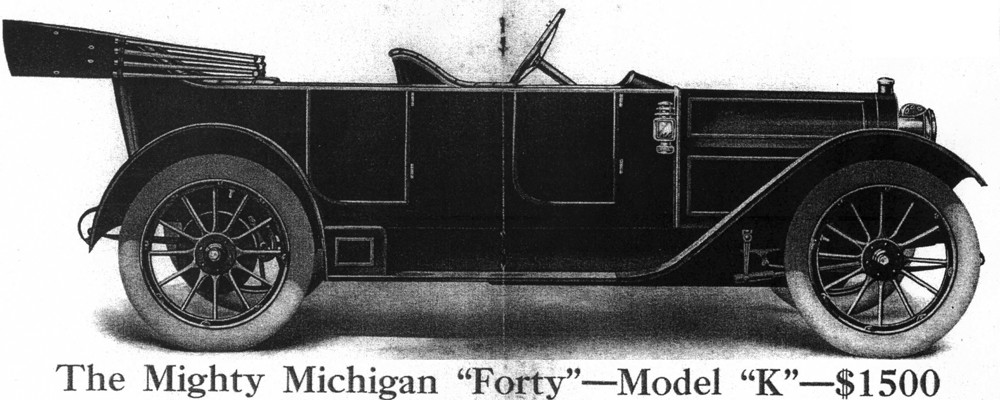I had never heard of such a thing until we first saw this car in Steve Dickey’s barn in Hebron, Indiana in 2011. Apparently, they were not very popular. My guess is that 1912 & 1913 were huge transition years for automobile technology — the very slow adoption of anything “NEW” by Ford Motor Company notwithstanding. Other car companies were innovating furiously. The “self-starter” was one such area.
Most cars had either carbide generators or Prest-O-Lite tanks for acetylene to light the headlights. Some cars, such as the MICHIGAN had electric lights in 1910 and then stepped backwards and reintroduced acetylene headlamps. Might acetylene headlamps have been cheaper? Maybe electric lighting was less reliable because of poor batteries or generators? The answers to those questions will require some research. Whatever the reasons, the MICHIGAN advertising offered both electric and acetylene starters. I know of at least one other 1912 Model K, like ours that had an acetylene starter.
 Here is an advertisement (above) from a 1912 automobile journal that promotes the PREST-O-STARTER, sold by the Prest-O-Light company, later to become the Union Carbide company. If you observe other cars from this era, you will see that MANY have Prest-O-Lite tanks strapped horizontally to their running boards. These tanks were for lighting headlights — NOT for starters. These tanks were an improvement over the calcium carbide and water drip “acetylene generators” that even earlier cars had on their running boards. Prest-O-Lite tanks were sold from general stores, gas stations, hardware stores the same way we currently swap empty and buy full propane tanks for our gas BBQs. Prest-O-Lite had what they thought was a “captive” audience for folks with older cars that didn’t have starters, but did have acetylene headlights. I am told that Prest-O-Lite tanks could be obtained everywhere, so travelers didn’t have to worry about refilling them.
Here is an advertisement (above) from a 1912 automobile journal that promotes the PREST-O-STARTER, sold by the Prest-O-Light company, later to become the Union Carbide company. If you observe other cars from this era, you will see that MANY have Prest-O-Lite tanks strapped horizontally to their running boards. These tanks were for lighting headlights — NOT for starters. These tanks were an improvement over the calcium carbide and water drip “acetylene generators” that even earlier cars had on their running boards. Prest-O-Lite tanks were sold from general stores, gas stations, hardware stores the same way we currently swap empty and buy full propane tanks for our gas BBQs. Prest-O-Lite had what they thought was a “captive” audience for folks with older cars that didn’t have starters, but did have acetylene headlights. I am told that Prest-O-Lite tanks could be obtained everywhere, so travelers didn’t have to worry about refilling them.
The reason for Prest-O-Lite getting into the starter business seems apparent, if one assumes that a better self-starter wouldn’t be invented – and headlights would continue to use acetylene. (Electric headlights and electric starters were both in their infancy in 1912). Many of the cars on the road in 1912 had only one means of starting — hand cranking. The Prest-O-Starter could be retrofitted into any automobile that had priming cups. A schematic of how this starter worked is extracted from Dyke’s Automobile and Gasoline Engine Encyclopedia 1915-1916 Ed. below.
 I keep asking around to see if anyone in the antique auto groups knows anyone with an acetylene starter on their car(s) and if anyone has seen one used. The best answer I’ve gotten so far is “Yes, I’ve heard of them.” Nobody seems to have a car with one and absolutely no one has seen one work. A few who have heard of an acetylene starter claim that they are “very dangerous” and that “some guy somewhere, sometime blew up his car”. Of this, I am extremely skeptical. It’s all 3rd hand hogwash as far as I can tell. I’ll keep looking and keep restoring, with the intent to some day start the car on acetylene. These are, after all, internal combustion engines – that run on…. Ladies & Gentlemen, hold on to your hats —— EXPLODING air & gasoline vapor.
I keep asking around to see if anyone in the antique auto groups knows anyone with an acetylene starter on their car(s) and if anyone has seen one used. The best answer I’ve gotten so far is “Yes, I’ve heard of them.” Nobody seems to have a car with one and absolutely no one has seen one work. A few who have heard of an acetylene starter claim that they are “very dangerous” and that “some guy somewhere, sometime blew up his car”. Of this, I am extremely skeptical. It’s all 3rd hand hogwash as far as I can tell. I’ll keep looking and keep restoring, with the intent to some day start the car on acetylene. These are, after all, internal combustion engines – that run on…. Ladies & Gentlemen, hold on to your hats —— EXPLODING air & gasoline vapor.
Here are some pictures of the actual device that is in our car- click on photo to enlarge.
Firewall side
 Here is what it looks like on the dashboard side.
Here is what it looks like on the dashboard side.

Here is what the Prest-O-Starter pump looks like disassembled:









